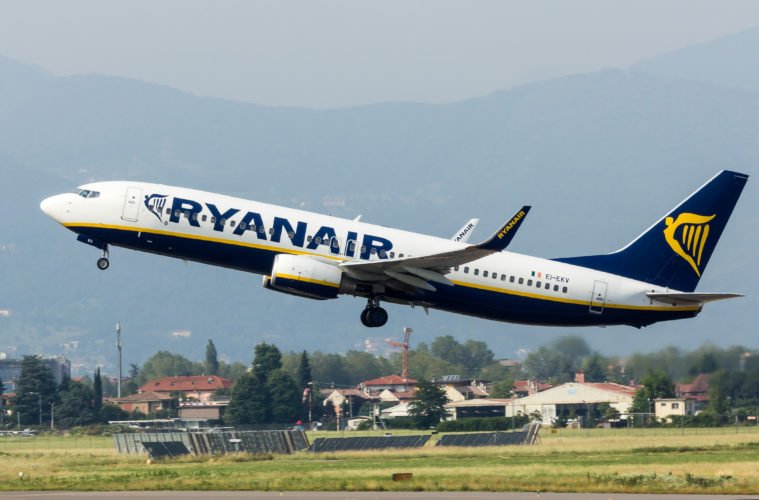ELECTRIC SKIES
With improvements in electric motors and battery technology the world is now racing to build short and medium haul planes that produce zero emissions. Promising to be cheaper to operate than fossil fuelled aircraft, electric aircraft also offer quieter skies, shorter runways and lower passenger ticket prices. Just like electric cars in the late 1800s, there were early experiments with electric airships almost 150 years ago in France. Before the age of lithium-ion, nickel cadmium batteries simply couldn't hold enough charge given their weight to justify any form of electric aircraft other than hobby and models. Commercial aviation accounts for about 2.5% (1 billion tons per year) of global CO2 emissions. Although this number may seem relatively small, considering cars account for ten times this number, it is still about as much as the entire South American continent emits in a year.
Commercial Aeroplane
Worse still, air traffic is one of the most polluting forms of transport per distance travelled. 500 kilometers by aircraft is 10 to 50 times more polluting than covering the same distance in a high-speed electric train and 5 to 10 times more polluting per passenger than using a bus. For example, a car will produce 43 grams of CO2 per kilometer travelled on average versus a domestic airline flight producing 133 grams. There is also a secondary impact from flying equivalent to another 121 grams per kilometer due to high altitude flights causing increased warming effects from other non-CO2 gases such as nitrogen oxides. Achieving sustainable aviation has been a huge focus of airlines over the last number of years as negative media attention on individual’s carbon footprints grew. Great strides have been made to improve aircraft efficiency, composite lightweight materials, more efficient engines and better fuels that have consistently lowered air pollution emissions since the 1970s. However, just like with the internal combustion engine, we are reaching the limits of what can be achieved with fossil fuel burning jets.
So, can we ever build an electric passenger plane that could also be recharged from renewable energy sources, say big solar and energy storage installations at airports for example? The answer today is partially yes. Cost and turnaround times for modern airlines is paramount as planes make no money sitting on the ground. I once watched a Ryanair plane land at Belgium’s Charleroi airport, complete a full turnaround and take off again in just 40 minutes. Charging an electric plane at this speed isn’t possible today. The number one issue to overcome is energy output per weight of a battery versus fuel. Right now, jet fuel contains far more punch than a battery by weight. Modern lithium-ion cells can produce about 250-Watt hours per kilogram while commercial aviation fuel is closer to 12,000 Watts per kilogram!
A 10-seater eVTOL is one thing but building a large electric commercial aircraft capable of transporting several hundred passengers over thousands of kilometers is a completely different proposition. We are quite a way off from a fully electric commercial aircraft, battery weight would need to drop at an exponential rate to deliver the same weight to power ratio and high performance as jet A1 fossil fuel. It’s not just about being able to carry the weight of electric batteries, it's also about developing electric motors that are powerful enough to compete with modern jet engines. Today’s jet engines are incredibly reliable and capable of enormous thrust and power, bringing heavy commercial aircraft to travel at 75% the speed of sound, up to 600 mph.
Despite these massive engineering challenges, once again the electric revolution is spilling over into the aviation world in a big way. Until battery technology evolves to enable small
electric commercial aircraft to become a reality, there are interim solutions including hydrogen fuel cell technology.
Boeing 737
It is certain that short haul, medium sized electric aircraft will come before larger long-distance airliners. Long haul jumbo jet sized electric planes are quite a way off, but the good news is that roughly 45% of global passenger air traffic is less than 500 miles. Typically, these short haul flights are serviced by smaller aircraft like a Boeing 737 or Airbus A320/319 which typically carries just 120-150 passengers. Short haul flights produce a higher CO2 output per kilometer than long haul because they never achieve long distance durations at cruising altitude. High altitude cruising is more efficient than relatively short takeoff and landing cycles.
Using heavy expensive commercial aircraft, designed to travel thousands of miles, for short hops is very inefficient but that's what we do today. Electric short haul flights may offer a possibility to have more and smaller airports than the giant international hubs of today. Short haul commuter routes will be better served by smaller and more regular zero emission electric aircraft designed for ranges of 500 miles or less. For this reason, the heavily polluting short haul flight market is the most attractive to be the first to go fully electric. In the US short haul flights accounts for about 12% of all carbon emissions. Building a plane that could fly 500 miles or more, carry 50 to 100 passengers at speeds of 300 plus miles an hour would vastly lower operating costs - this is the prize for electric aircraft.
This reality, for smaller electric commercial aircraft is closer than you may think. There are at least 10 startups in addition to major commercial aircraft manufacturers, like Boeing and Airbus, now working on an electric commercial plane.
Commercial jet engines have had over half a century of refinement and improvement. Today these engines, manufactured from companies like GE and Rolls-Royce, are among the most efficient and reliable machines ever built. They can deliver thousands of hours of flight safely, efficiently and in the worst possible environments. High speed electric fans and propellers have nowhere near this development pedigree. Building an electric motor capable of producing extreme high speeds in extreme conditions reliably and safely is vital if electric aircraft are to get flight certified.
Overcoming the motor and battery problem comes first, getting the world's aviation regulators to certify electric planes safe for passenger travel will be another challenge. Modern aviation is rigorously tested before certification. For these reasons we may see old airframes retrofitted in the meantime, before complete brand-new certified electric planes become a reality. With all the momentum now, building electric skies are an inevitability. The future of transportation is electric, there is no exception




